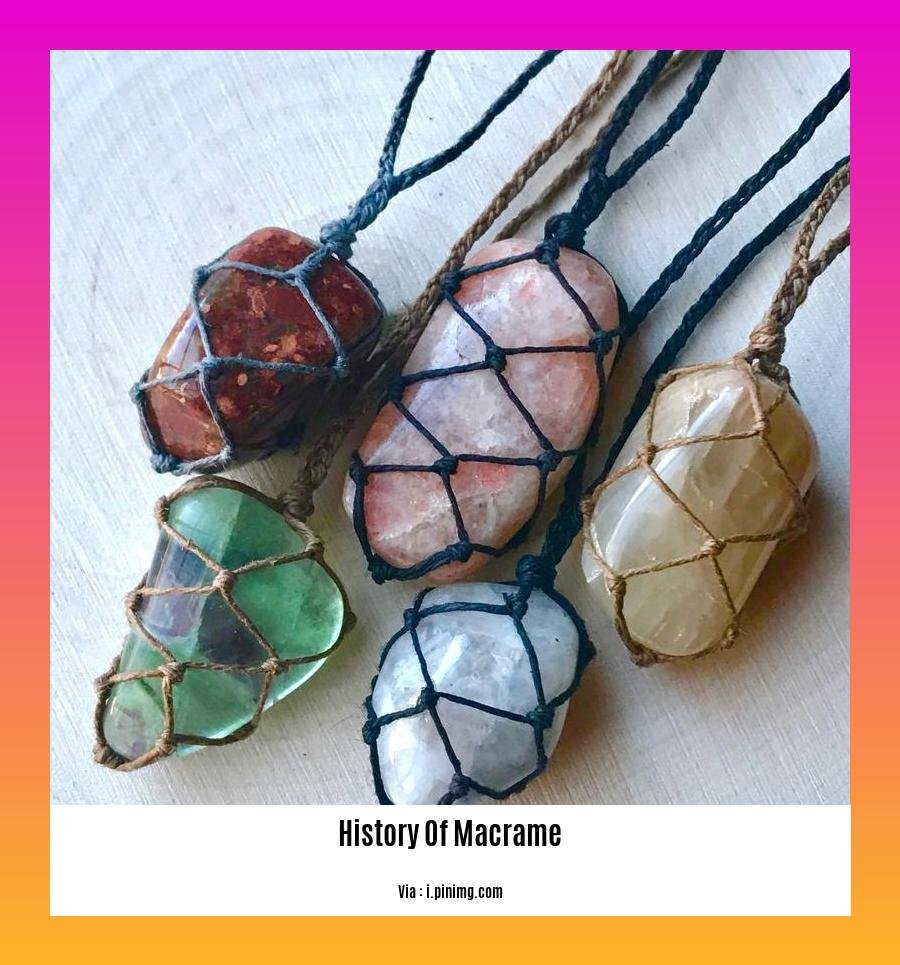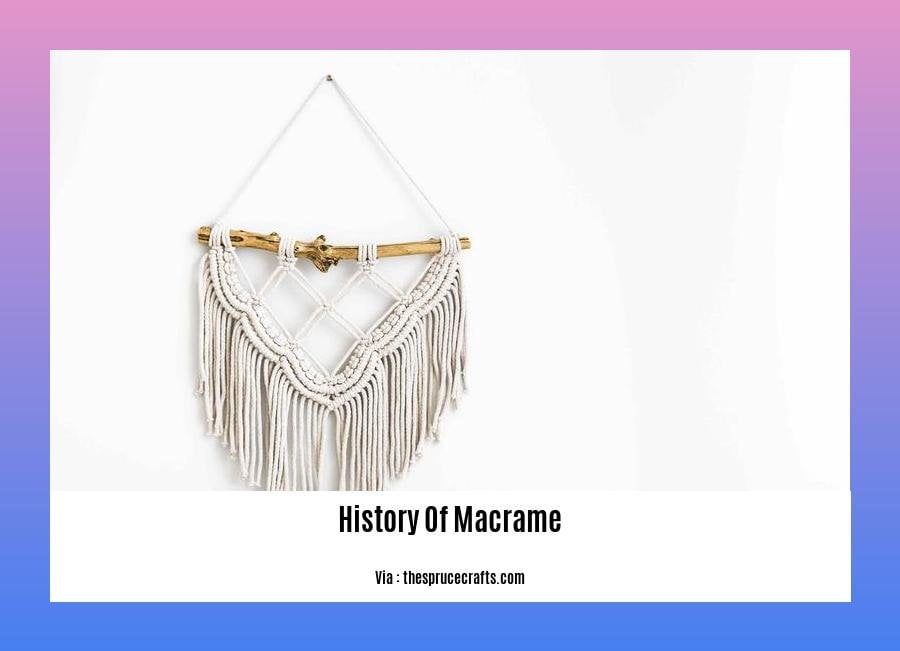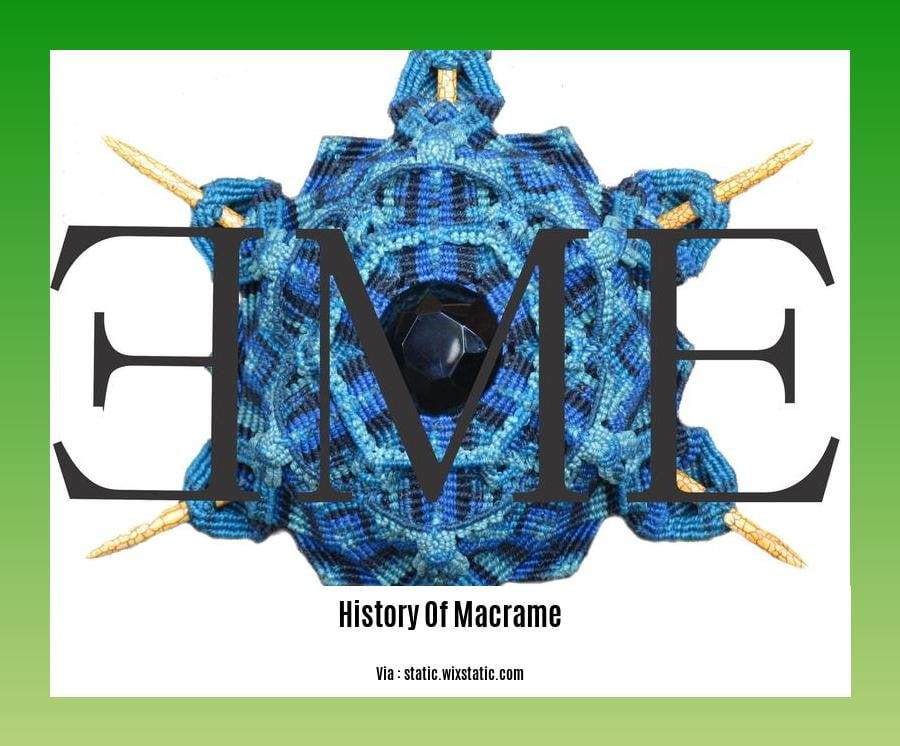Unveiling the Knotted History of Macrame: A Journey Through Time: Embark on a captivating journey through the rich tapestry of macrame’s history. From its humble origins in ancient civilizations to its modern-day revival as a beloved craft, explore the evolution of this versatile art form, its cultural significance, and its enduring appeal as a creative expression.
Key Takeaways:
- Macrame originated from Arabic weavers in the 13th century.
- It derives its name from the Arabic word for fringe or ornamental fringe.
- Sailors spread this art form to Europe.
- Macrame has possible origins in ancient China as well.
- Initially used to secure loose ends of hand-woven textiles, it evolved into a versatile decorative art form.
**History of Macrame: An Ode to Knotted Art**

In decorative artistry, macrame holds a timeless allure, captivating the hearts and minds of artisans worldwide. Its intricate knots, meticulously woven together, evoke a sense of wonder and tranquility. Embark on a journey through time to unravel the rich history of macrame, a craft that has gracefully endured the test of centuries.
**Ancient Roots: A Timeless Legacy**
Macrame’s origins can be traced back to the 13th century, when Arabic weavers ingeniously crafted decorative fringes and embellishments using intricate knotting techniques. The term “macrame” itself is derived from the Arabic word “migramah,” meaning “ornamental fringe.”
**Embracing Cultural Diversity: The Silk Road Connection**
Through the dynamic exchange of ideas along the ancient Silk Road, macrame’s influence spread far and wide, captivating artisans and cultures across continents. Sailors, with their innate curiosity and adaptability, enthusiastically adopted this art form, incorporating it into their nautical endeavors.
**European Flourishing: A Tapestry of Traditions**
As macrame found its way into the hands of European artisans, it flourished amidst various cultural influences. In the 16th century, Italy embraced macrame as a decorative element in exquisite lace-making, showcasing its versatility and refined elegance.
**A Resurgence of Popularity: Modern Interpretations**
The 20th century witnessed a revival of interest in macrame, fueled by a wave of bohemian and artisanal movements. The 1970s marked a significant resurgence, as macrame became a symbol of counterculture and self-expression, adorning everything from wall hangings to plant hangers.
**Macrame Today: A Fusion of Art and Craftsmanship**
In contemporary times, macrame continues to captivate artists, designers, and hobbyists alike. It has evolved into a diverse art form, encompassing intricate wall hangings, boho-chic jewelry, and stylish home décor.
**Preserving Traditions: Macrame in the Digital Age**
In the digital realm, social media platforms and online workshops have become vibrant communities where macrame enthusiasts share their knowledge, showcase their creations, and inspire others to embrace this timeless art form.
**Sustainability and Mindfulness: A Modern Ethos**
In keeping with modern values of sustainability and mindfulness, contemporary macrame artists often incorporate eco-friendly materials and ethical sourcing practices into their work. This fusion of traditional techniques with a modern ethos has transformed macrame into an art form that resonates with today’s conscious consumers.
**Macrame: An Enduring Legacy**
Throughout history, macrame has woven its way through diverse cultures and time periods, adapting and evolving to reflect the spirit of each era. From its humble beginnings as a practical craft to its current status as a celebrated art form, macrame continues to inspire and captivate, reminding us of the enduring power of human creativity and craftsmanship.
- Learn about how light switches came to be!
- Find out the intriguing journey of how Little League baseball started.
- Did you know about the astonishing history of long hair? Discover it here.
Navigational Tool: Discovering the significance of macrame in maritime history, where sailors relied on knotted cords to create nets, measure distances, and record important data.
Key Takeaways:
Sailors used macrame to craft sturdy and reliable fishing nets that could withstand the rough seas and capture their catch efficiently.
Macrame knots were instrumental in creating depth lines for accurate depth measurements and determining the ideal location for dropping the anchor to ensure a safe and secure hold.
Sailors relied on intricate macrame knots to construct cargo nets that safely stored and transported valuable goods on long voyages, safeguarding them from damage and loss.
Macrame knots played a vital role in creating hauling lines, enabling sailors to effortlessly raise and lower sails, maneuver heavy objects, and perform various tasks on deck.
Macrame served as a practical solution for securing valuable equipment and tools on board the ship, preventing them from shifting or falling during rough seas.
Imagine the vast expanse of the ocean, a sailor’s playground, where the only guide was the stars above and the knots they tied. Macrame, the art of knotting cords, was not merely a pastime for these seafarers; it was an essential skill that aided them in navigating the vast, unpredictable waters.
Fishing nets, sturdy and reliable, were crafted using macrame knots. These nets, carefully knotted, ensured a bountiful catch, providing sustenance and nourishment for the crew during their long journeys.
Depth lines, meticulously measured and marked with intricate knots, allowed sailors to accurately gauge the depth of the water, helping them avoid treacherous shallows and ensuring a safe passage through uncharted waters.
Cargo nets, suspended securely with macrame knots, cradled precious goods and supplies, safeguarding them from the perils of the sea. These nets prevented damage and loss, ensuring that essential items reached their destination intact.
Hauling lines, strong and durable, were knotted together using macrame techniques. These lines enabled sailors to effortlessly raise and lower sails, maneuver heavy objects, and perform various tasks on deck, ensuring the smooth operation of the ship.
Equipment, essential for the ship’s operation, was secured using macrame knots. Tools, weapons, and other valuable items were tied down, preventing them from shifting or falling during rough seas, ensuring the safety of the crew and the integrity of the ship.
Macrame, in the hands of skilled sailors, transformed simple cords into indispensable tools, essential for survival and navigation. It was a testament to the ingenuity and adaptability of these seafarers, who relied on their knowledge and skills to conquer the vast and unforgiving ocean.
Citations:
[1]
[2]
Knotted Symbolism: Delving into the symbolic meanings associated with macrame in various cultures, representing everything from love and friendship to protection and spiritual beliefs.

Imagine macrame as a knotted language, whispering stories of love, friendship, protection, and spiritual beliefs across cultures. Each knot, a symbol waiting to be unveiled, invites us on a journey through time and traditions.
Love and Friendship:
In the realm of love and friendship, macrame knots intertwine to form intricate patterns, embodying the unbreakable bonds between souls. Sailors, venturing across vast oceans, would knot intricate friendship bracelets, each knot a silent promise of their camaraderie.
Protection and Healing:
Ancient Egyptians believed in the protective power of knots, adorning their amulets and talismans with intricate macrame designs. These knots were believed to ward off evil spirits, ensuring the well-being of the wearer.
Spiritual Beliefs:
In many cultures, macrame knots held deep spiritual significance. Buddhists believed that the intricate knots in their prayer malas represented the interconnectedness of all things, a symbol of their spiritual journey. Native American tribes wove intricate dreamcatchers, each knot a prayer for protection and guidance.
Swan Symbolism:
Swans, graceful creatures of water and sky, have long been associated with symbolism in various cultures. Their elegant forms, often incorporated into macrame designs, represent purity, grace, and transformation.
Key Takeaways:
Love and Friendship: Macrame knots symbolize the unbreakable bonds of love and friendship, often seen in friendship bracelets and decorative knots.
Protection and Healing: Ancient Egyptians believed in the protective power of knots, using them in amulets and talismans to ward off evil spirits.
Spiritual Beliefs: Buddhist prayer malas and Native American dreamcatchers incorporate intricate knots, representing spiritual interconnectedness and protection.
Swan Symbolism: Swans, often depicted in macrame designs, symbolize grace, purity, and transformation.
Sources:
Symbolism of Knots: Unraveling the Meaning
Swan Symbolism & 9 Meanings: Understanding The Spiritual …
Modern Revival: Investigating the resurgence of macrame in contemporary times, driven by the rise of handmade crafts, bohemian aesthetics, and sustainability consciousness.
In the realm of contemporary crafts, macrame, an ancient art of knotting, has experienced a remarkable resurgence, captivating the hearts of modern-day enthusiasts. This revival is intricately intertwined with the rise of handmade crafts, the allure of bohemian aesthetics, and the growing consciousness of sustainability.
Into the Threads of Time: A Journey of Knots
Macrame, with its origins rooted in the 13th century, has journeyed through diverse cultures and time periods, leaving an imprint of creativity and craftsmanship. From intricate Arabic designs to European lace-making, macrame’s versatility and elegance have endured. The 20th century witnessed a revival of interest, driven by the bohemian and artisanal movements. In the 1970s, macrame experienced a surge in popularity, becoming a symbol of counterculture, a celebration of individuality and artistic expression.
Unveiling the Allure: A Symphony of Crafts, Aesthetics, and Sustainability
The resurgence of macrame in contemporary times can be attributed to a confluence of factors. Firstly, the growing appreciation for handmade crafts has played a pivotal role. In an era of mass production, the unique and personal touch of handmade creations resonates with consumers seeking authenticity and individuality. Macrame, with its intricate knots and customizable designs, offers a delightful escape from the uniformity of factory-made products.
Secondly, the bohemian aesthetic, characterized by its eclectic and free-spirited nature, has embraced macrame as a symbol of its values. Macrame’s intricate patterns, natural materials, and handcrafted essence align perfectly with the bohemian lifestyle, evoking a sense of adventure, creativity, and connection with nature.
Last but not least, the growing consciousness of sustainability has further fueled the popularity of macrame. The use of natural materials, such as cotton, jute, and hemp, aligns with the eco-friendly ethos of many modern consumers. Macrame’s durability and versatility make it a sustainable choice for various home décor and accessory needs, reducing waste and promoting mindful consumption.
Macrame Today: A Canvas of Creativity and Expression
In the contemporary world, macrame has evolved into a diverse and vibrant art form. From intricate wall hangings that adorn living spaces to stylish jewelry that adorns bodies, macrame’s versatility knows no bounds. Modern macrame artists are constantly pushing the boundaries, experimenting with new techniques, colors, and materials to create unique and innovative pieces that cater to diverse tastes and styles.
Key Takeaways:
Handmade Revival: Macrame’s resurgence aligns with the growing appreciation for handmade crafts, offering a unique and personal touch to modern interiors.
Bohemian Aesthetic: The free-spirited and eclectic nature of the bohemian aesthetic has embraced macrame as a symbol of adventure, creativity, and connection with nature.
Sustainability Consciousness: Macrame’s use of natural materials and durability aligns with the growing consciousness of sustainability, promoting mindful consumption and reducing waste.
Diverse Expressions: Contemporary macrame encompasses a wide range of creations, from intricate wall hangings to stylish jewelry, catering to diverse tastes and styles.
Cultural Fusion: Macrame’s global journey has resulted in a fusion of cultural influences, creating a diverse and vibrant art form that draws inspiration from various corners of the world.
Sources:
1
2
FAQ
Q1: What are the origins of macrame?
A1: Macrame’s roots can be traced back to ancient Arabic weavers in the 13th century. Initially used to create decorative trims and fringes, the term “macrame” is derived from the Arabic word for “ornamental fringe.”
Q2: How did macrame spread to Europe?
A2: Sailors played a crucial role in disseminating macrame techniques throughout Europe. As they traveled the seas, they incorporated macrame knots into their nautical endeavors, using them for tasks like securing ropes and hammocks.
Q3: Is there any evidence of macrame in ancient cultures other than the Middle East?
A3: While the origins of macrame are often associated with Arabic weavers, there is evidence of similar knotting techniques being employed in ancient China. However, the extent of this influence and the relationship between these two regions in terms of macrame remain topics of ongoing research.
Q4: How did macrame evolve from a practical technique to an art form?
A4: Initially used for functional purposes like securing textiles and creating decorative trimmings, macrame’s versatility led to its gradual transformation into an art form. Artisans began experimenting with different knotting styles and patterns, creating intricate and visually appealing designs. This evolution paved the way for macrame to become a form of artistic expression.
Q5: What are some of the cultural influences that have shaped the development of macrame?
A5: Macrame has been influenced by various cultures throughout history. Sailors from different nations incorporated their own styles and techniques into the art form, leading to a diverse range of macrame designs. Additionally, macrame has been used in various cultural ceremonies and rituals, imbuing it with symbolic and spiritual significance.
- Georgia Platform: A Southern Strategy, 1850s - March 31, 2025
- How many weeks is 40 days: Quick Conversion Guide for Accurate Results - March 31, 2025
- How many feet is 300 meters? 984 Feet: Understand Length Conversions Easily - March 31, 2025
















